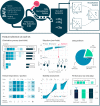The Multi-Partner Consortium to Expand Dementia Research in Latin America (ReDLat): Driving Multicentric Research and Implementation Science
- PMID: 33776890
- PMCID: PMC7992978
- DOI: 10.3389/fneur.2021.631722
The Multi-Partner Consortium to Expand Dementia Research in Latin America (ReDLat): Driving Multicentric Research and Implementation Science
Abstract
Dementia is becoming increasingly prevalent in Latin America, contrasting with stable or declining rates in North America and Europe. This scenario places unprecedented clinical, social, and economic burden upon patients, families, and health systems. The challenges prove particularly pressing for conditions with highly specific diagnostic and management demands, such as frontotemporal dementia. Here we introduce a research and networking initiative designed to tackle these ensuing hurdles, the Multi-partner consortium to expand dementia research in Latin America (ReDLat). First, we present ReDLat's regional research framework, aimed at identifying the unique genetic, social, and economic factors driving the presentation of frontotemporal dementia and Alzheimer's disease in Latin America relative to the US. We describe ongoing ReDLat studies in various fields and ongoing research extensions. Then, we introduce actions coordinated by ReDLat and the Latin America and Caribbean Consortium on Dementia (LAC-CD) to develop culturally appropriate diagnostic tools, regional visibility and capacity building, diplomatic coordination in local priority areas, and a knowledge-to-action framework toward a regional action plan. Together, these research and networking initiatives will help to establish strong cross-national bonds, support the implementation of regional dementia plans, enhance health systems' infrastructure, and increase translational research collaborations across the continent.
Keywords: Alzheimer's disease; Latin America; SDOH; SES; dementia; fronto-temporal dementia; genetics; implementation science.
Copyright © 2021 Ibanez, Yokoyama, Possin, Matallana, Lopera, Nitrini, Takada, Custodio, Sosa Ortiz, Avila-Funes, Behrens, Slachevsky, Myers, Cochran, Brusco, Bruno, Brucki, Pina-Escudero, Okada de Oliveira, Donnelly Kehoe, Garcia, Cardona, Santamaria-Garcia, Moguilner, Duran-Aniotz, Tagliazucchi, Maito, Longoria Ibarrola, Pintado-Caipa, Godoy, Bakman, Javandel, Kosik, Valcour and Miller.
Conflict of interest statement
The authors declare that the research was conducted in the absence of any commercial or financial relationships that could be construed as a potential conflict of interest.
Figures








References
-
- Ibanez A, Parra MA, Butler C. For Latin America and the Caribbean Consortium on Dementia (LAC-CD). The Latin America and the Caribbean Consortium on Dementia (LAC-CD): From Networking to Research to Implementation Science. J Alzheimers Dis. (2021). 10.3233/JAD-201384. [Epub ahead of print]. - DOI - PMC - PubMed
-
- Association AP. Diagnostic and Statistical Manual of Mental Disorders (DSM-5®). Arlington, VA: American Psychiatric Pub; (2013).
Publication types
Grants and funding
LinkOut - more resources
Full Text Sources
Other Literature Sources

